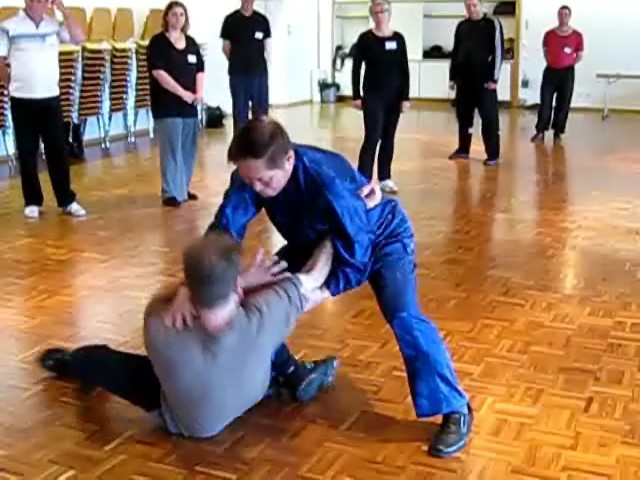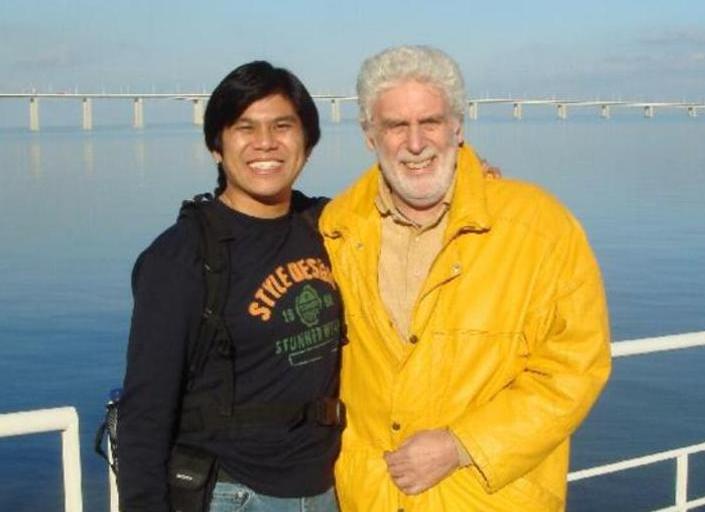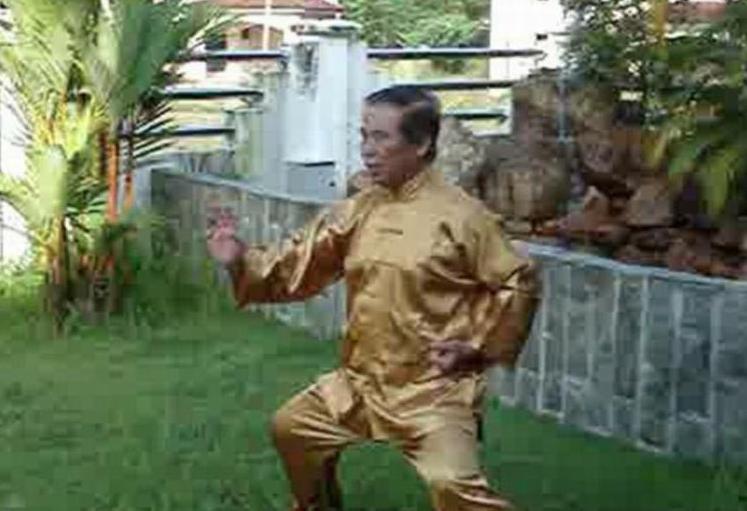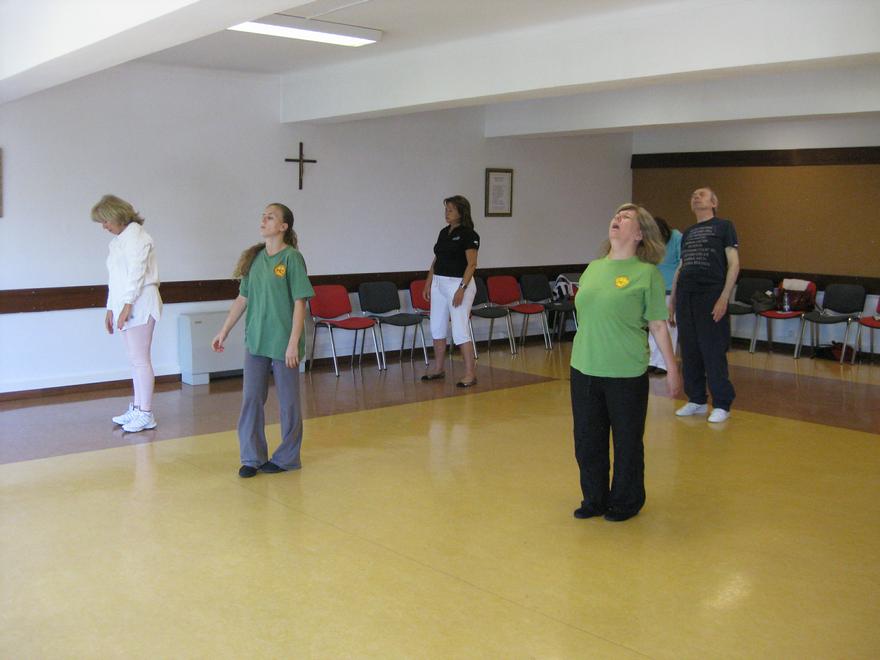SELECTION OF QUESTIONS AND ANSWERS
JULY 2012 PART 2

Taijiquan is a martial art, not a dance
Question 1
I have practiced Tai Chi for many years. You have said that Tai Chi is a martial art. I don't know whether we can defend ourselves. We never do any sparring.
— Dan, Australia
Answer
Tai Chi Chuan, or Taijiquan in its Romanized Chinese spelling, is an internal martial art. The word "chuan", or "quan", means "martial art", though literally it means "fist". It is what in the West would be referred to as "kungfu". Hence, Shaolin Kungfu is Shao Lin Chuan, or Shaolinquan in Romanized Chinese, and Lohan Kungfu is Luo Han Chuan, or Luohanquan.
Tai Chi, or Taiji in Romanized Chinese, literally means "grand ultimate", but figuratively means the Cosmos. Hence translated into English, Tai Chi Chuan, or Taijiquan, is Cosmos Kungfu.
But today more than 90% of people who practice Tai Chi Chuan, which they usually shortened to Tai Chi, not as an internal martial art but as an external dance-like exercise. This appears to be what you are practicing. Only a rare minority of Tai Chi Chuan practitioners practice it as an internal martial art. If you have not practiced any sparring, it is unlikely you can defend yourself in a fight.
Question 2
I asked my instructor whether we could use Tai Chi for fighting. He said it would take many years. I asked why we did not do sparring like in other martial arts. He said it was too dangerous.
Answer
What your instructor said is common amongst Tai Chi instructors when students ask them such questions. It is not true that Tai Chi Chuan students would take many years to learn how to fight. In our school, our Tai Chi Chuan students learn combat application within a few months. On the other hand, those who practice Tai Chi as an external dance-like exercise would be unable to fight even if they practice for many years.
It is also not true that sparring with Tai Chi Chuan is dangerous. In our school, Tai Chi Chuan students do not sustain any injuries when sparring. In fact they find Tai Chi Chuan sparring a lot of fun. In other schools where Tai Chi Chuan sparring is ever taught, students sustain far less injuries than in other martial arts.

An initiated observer would be able to tell that Sifu Wong Chun Nga and Sifu Riccardo Salvatore pictured above are full of internal force
Question 3
You also say about internal force. How do I know whether I have internal force or not? How do I know about our instructor? He is in his 50s and he looks healthy.
Answer
Internal force is an essential aspect of genuine Tai Chi Chuan. In other martial arts, like Wing Choon Kungfu, Karate and Muay Thai, practitioners may not have internal force but can still be very combat efficient.
But it is not so in Tai Chi Chuan. Without internal force, Tai Chi Chuan practitioners cannot be combat efficient. Without internal force, Tai Chi Chuan may not even be good for health.
Asking how you know whether you have internal force is an academic question. It shows you have no internal force. If you have, you would know it from direct experience, in the same way that if you are hungry or have an apple in your hand, you will know it.
One sure feature of a person having internal force is good health. But, on the other hand, being healthy does not necessarily indicate that the person has internal force. In other words, while people with internal force are healthy, there are also healthy people who have no internal force. Your Tai Chi teacher is probably an example.
Nevertheless, there are certain signs by which an initiated observer can tell not only whether a person has internal force but also how much internal force he has. These signs include the roundness of his limbs, a small protrusion at his abdomen, the sparkle in his eyes, the volume of his voice, and the steadiness of his walk.
A person with internal force is also soft-spoken, gentle and elegant. A tell-tale sign is that he is relaxed -- physically and mentally -- even when he has to exert strength. Another tell-tale sign is that he is full of vitality.
Question 4
What is the difference between using One-finger Zen and Dragon Hand-Form in Dim Mark?
— Nick, England
Answer
Both the One-Finger Zen and the Dragon Hand-Form (sometimes called the Two-Finger Zen) are choice hand-forms for Dim Mark, or dotting vital points. The index finger is used for Dim Mark in One-Finger Zen, whereas the middle finger is used in Dragon Hand-Form.
The force of One-Finger Zen is relative softer. Hence, one may feel using the Dragon Hand-Form is more powerful, but it may not actually be so -- it is just the feeling. In fact, the injury cased by One-Finger Zen in Dim Mark is generally more serious than that caused by Dragon Hand-Form, but this may not due to force alone, it may be due to mind or force control.
Relatively and at a physical level, Dragon Hand-Form has better control than One-Finger Zen in aiming at targets. This is significant at the training stage when a Dim Mark practitioner practices striking his One-Finger Zen or Dragon Hand-Form at vital points of a wooden man or a chart pasted on a wall.
But in application, it may not matter because it is the chi of the practitioner guiding his finger to the target on an opponent. It is like a guided missile chasing its flying target. Hence, those who say that it is difficult to strike the vital point of a moving opponent does not have direct experience of Dim Mark.
Dim Mark is sometimes described as the death-touch. It is not quite correct. In fact a Dim Mark master is compassionate. Instead of causing an internal injury or breaking an opponent's bones, he disables him temporarily. The victim can later seek another master or a good Chinese physician to rectify the injury. On course, if left alone, a Dim Mark injury can be very serious.

Grandmaster Wong demonstrating Two-Finger Zen
Question 5
I have heard that the eyes are few areas of the body where chi cannot be directed to. Can chi be manipulated in the eye, say by an external qigong healer? Would that be too dangerous?
— Richard. USA
Answer
This is not true. You yourself or someone else can direct chi to your eyes. If chi fails to flow to an eye, it will be useless.
Chi can be safely manipulated in the eye by an external qigong healer or internally by the person himself.
Question 6
If the counting leaves exercise isn't done, will the other 7 exercises still be effective?
Answer
Yes, the other exercises will be effective even when counting leaves is left out. The eye exercises are independent, i.e. they can be performed on their own without combining with any other exercises to bring benefits.

"Flowing Breeze and Swaying Willows" during a chi kung class in Portugal
Question 7
Sigung, you have mentioned that having a chi flow after stance training is very important. Can you please elaborate?
— Adam, USA
Answer
Yes, having a chi flow after stance training, especially after the Horse-Riding Stance, Golden Bridge and the Three-Circle Stance, is very important. Students will miss more than half the benefit they could have if they fail to have a chi flow after stance training. This was a well-kept secret, and not many people know about it.
When the chi flow is gentle, it is poetically described as "yew foong pai lou" (Cantonese pronounciation) or "flowing breeze swaying willows". If it is vigorous, it is poetically described as "lau shui hang wan" or "flowing water floating clouds".
If after stance training a student can spontaneously go into a chi flow, it is a good indication that he was relaxed in his stances. If he was tensed, he would not be able to enter a chi flow.
There are three areas of benefit a chi flow after stance training can bring.
If a student has practiced his stance wrongly and therefore has sustained some injury, his chi flow will immediately clear the blockage, thus overcoming the injury.
Secondly, the chi flow will spread the internal force he has developed during the stance training all over his body. This will help him to overcome illness or injury if he has any. (The illness or injury were present before his stance training.) If he is already healthy, the internal force will strengthen his internal organs and give him vitality.
This is a very important point even some masters neglect or are unaware of. Despite having internal force, some masters are not healthy! It is because they channel their internal force for combat or for demonstration. This will also affect their longevity. If they have a chi flow after their stance training, they will overcome these problems.
Thirdly, the chi flow increases the amount of internal force derived from the stance training. This is because during the chi flow, energy from the Cosmos also flows into him.
Question 8
Should we have a chi flow after some force training too, like Two-Finger Zen and Cloud Hands?
Answer
Yes, doing so will increase the amount of internal force, besides other benefits described in the earlier answer above.
Suppose a student has 1,000,000 units of energy, and after a force training session like Two-Finger Zen and Cloud Hands, he increases his energy by 100 units.
If he does not follow up with a chi flow, he would now have 1,000,100 unites of energy. 10% of the energy he has just acquired would naturally flow from his arms into his body even when he does not enter into a chi flow. So he now has 1,000,010 units of energy in his body, and 90 units of energy in his arms. Of course the figures may not be exact, but they give a good picture of what is happening.
If he has a chi flow, 40% of the energy he has just acquired will flow into his body. But it is not just this 40 units of energy flowing in his body. Much of his original 1,000,000 units of energy will also be flowing. This chi flow will attract, say, 20 units of energy from the Cosmos. So now the total amount of energy in his body is 1,000,120 units, instead of 1,000,100 units had he not have a chi flow.
Initially his arms will not be as powerful because some of the energy has flowed into the body. If he does not have a chi flow, his arms have 90 units of energy from his force training, as 10 units have naturally flowed into his body. If he has a chi flow, his arms have 60 units of energy, as 40 units have flowed into his body.
However, he will have more energy in both his body as well as his arms because he has 20 units more energy per session due to the addition of energy from the Cosmos during chi flow. Although initially his arms are less powerful due to some energy flowing into the body, eventually his arms will be more powerful due to the increase which will catch up and then surpass the energy flowing into the body.
Moreover, if he needs to, he can more readily channel energy from his body to his arms to make them more powerful. He will be less efficient in doing so if he does not have regular chi flow after stance training, in which case his energy is more locked in his arms.
LINKS
Selected Reading
- A Dragon has Awakened
- Perception is Often More Important than Rea;ity
- The State of Mind when Performing Iron Wire
- Is it Necessary to Attend Special Courses?
- Breathing Structures
